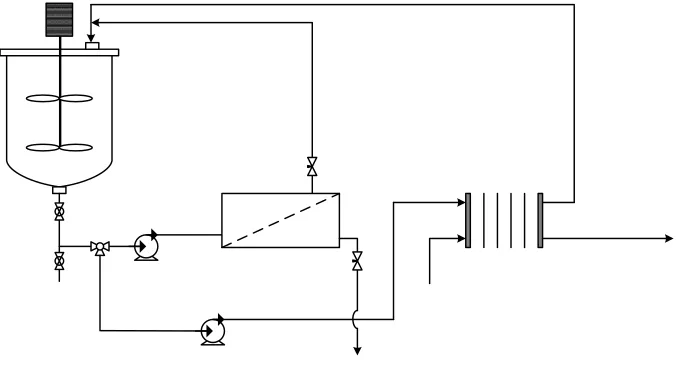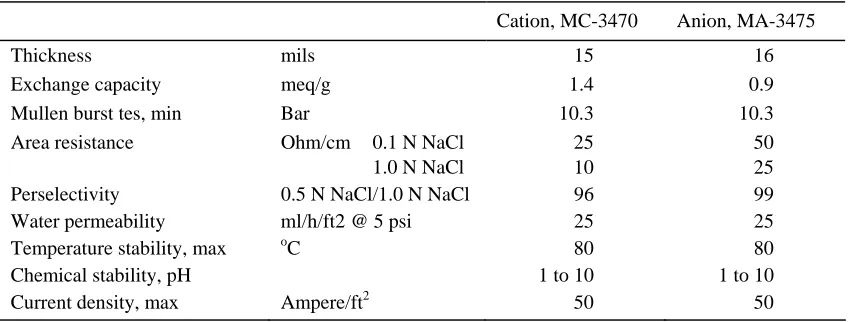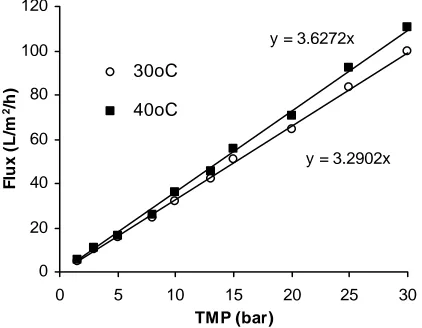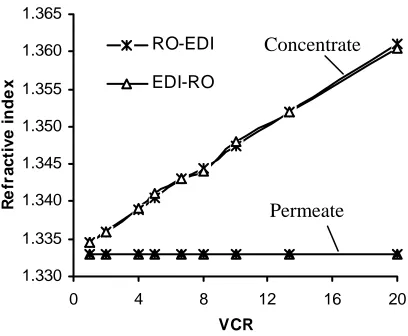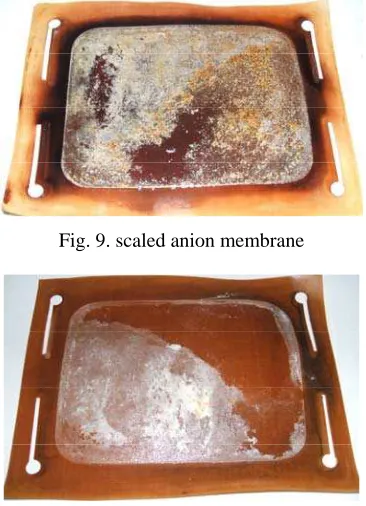COMBINATION OF REVERSE OSMOSIS AND
ELECTRODEIONIZATION FOR SIMULTANEOUS SUGAR
RECOVERY AND SALTS REMOVAL
FROM SUGARY WASTEWATER
I N. Widiasa
1)and I G. Wenten
2)Abstract
An integrated membrane system combining reverse osmosis (RO) and electrodeionization (EDI) is used for simultaneous sugar concentration and salts removal from a synthetic dilute sugar solution as a model of sugar-containing wastewater. The RO system uses a thin film composite RO membrane (Saehan CSM, RE1812-60). Meanwhile, the EDI stack has two diluted compartments, one concentrated compartment, one anode compartment, and one cathode compartment. Commercially available cation exchange membrane (MC-3470) and anion exchange membrane (MA-3475) are used as ionic selective barriers of the EDI stack. Both diluate and concentrate compartments are filled with mixed ion exchange resins (purolite strong acid cation exchange, C-100E and strong base type I anion resins, A-400). Two different operation modes, i.e. RO-EDI and EDI-RO, were assessed. The experimental results show that the observed sugar rejection of RO membrane is more than 99.9% and there is no sugar loss in the EDI stack. This indicates that the hybrid process allows almost total sugar recovery. In addition, significant reduction of salts content from the concentrated sugar solution is obtained. From permeate flux and permeate purity points of view, however, the EDI-RO configuration seems superior to the RO-EDI configuration. It should be emphasized that scale formation on the membrane surface of the concentrate compartment side has to be controlled.
Key words: electrodeionization; reverse osmosis; sugar recovery; sugary wastewater
Introduction
In the confectionery and beverage industries, sugar (in the form of sucrose, maltose, fructose, glucose, etc.) is the main constituent in most of the process streams. Inevitably, the effluent streams arising from these industries exhibits a high COD (chemical oxygen demand) due to the presence of sugar within the waste stream. Effluent having sugar concentration of 1% w/w produces a COD of about 10,000 mg/L. In addition to reduce the COD level, therefore, it is considerably interesting to optimize process economics through sugar recovery. Recently, a number of studies have been carried out to study the conversion of carbohydrates-containing solutions to hydrogen gas (Taguchi, et al., 1992; Ueno, et al., 1996; Mizuno, et al., 2000; Fang and Liu, 2002; Zang, et al., 2003)
1)
Chemical Engineering Department, Diponegoro University 91
Jl. Prof. Soedarto, SH. Kampus Tembalang, Semarang, Indonesia, 50239, Telp/Fax. 62-24-7460058; Email: widiasa_70@yahoo.com
2)
Chemical Engineering Department, Institut Teknologi Bandung Today, reverse osmosis (RO) is used for
desalination of sea and brackish water and for various industrial purposes. Generally, RO membranes capable of retaining most of dissolved solutes, including sugars and salts. To move water from the concentrated stream toward the permeate stream, the
operating pressure of the RO system must exceed the osmotic pressure of the solution. A number of studies (Prasetyo, et al., 2005; Pepper, et al., 1985; Rektor, et al., 2004; Hayakawa, 2001; Shimanskaya and Shimansky, 2002) have shown the RO feasibility for concentrating sugar-containing solutions, e.g. for concentrating fruits juice. Compared to conventional evaporation technology, RO offers some advantages: (i) sugar degradation by heat effect can be avoided so that the concentrated sugar solution may be reused directly within the process, provided the feed stream is not contaminated; (ii) RO requires a relatively low energy, using electrical power to run pumps; and (iii) being modular, small plant can be installed close to the source of effluent stream.
condition. By using average salts rejection of 97% (Shimanskaya and Shimansky, 2002), for example, VCR of 10 to 20, giving concentrated volume of 10% to 5% of the initial value, results in the increase of impurities concentration about 9.7 to 19.3 times. Without a further treatment, therefore, it may not be appropriate to reuse the recovered sugar within the process.
Experimental results using laboratory scale electrodeionization (EDI) unit to remove ionic component from sugar solutions (Widiasa, et al., 2002; Widiasa and Wenten, 2003; Widiasa, et al., 2004) and to recover citric acid (Widiasa, et al., 2004) have been reported. In this study, an integrated system combining RO and EDI is used for simultaneous sugar concentration and salts removal from a synthetic dilute sugar solution as a model of sugar-containing wastewater. Two different operation modes, i.e. RO-EDI and RO-EDI-RO, were assessed. Performance of the integrated system is evaluated in term of water removal rate (permeate flux) and conductivity and pH of the concentrated sugar solution.
Experimental Feed solution
A synthetic sugar solution was prepared for the experiments by diluting 200 g technical grade sucrose crystals within 20 L tap water at room temperature. For every experiment, a fresh solution was prepared. The solutions had a pH of 7.2 ± 0.3 and a conductivity of 250 ± 10 µS/cm. The solution was filtered by cartridge filter (10 µm) to remove insoluble matters prior to be treated by the integrated systems.
Experimental Set up
Figure 1 shows the schematic representation of the experimental setup used in this study, which consisted of a stirred feed tank, a RO module, a high pressure pump connected to a panel control, an EDI stack, a main adjustable DC power supply to generate a potential field in the EDI stack, three diaphragm pumps (Puricom UP-8000, maximum flow rate of 3 lpm, maximum pressure of 80 psi, motor 48VDC/2A/50hz) connected to a three output adjustable DC power supply, a concentrate tank and an electrodes rinse tank. The system is also equipped with a three way valve to switch the fluid flow either through the RO module or through the EDI stack. For simplicity, a number of such components is not depicted in Fig. 1. The RO unit used a thin film composite RO membrane (Saehan CSM, RE1812-60). The permeate channel of the module was little modified to be suited for the housing. The characteristics of the membrane are shown in Table 1. Meanwhile, the EDI stack consisted of two diluted compartments, one concentrated compartment, one anode compartment, and one cathode compartment. Commercially available cation exchange membrane (MC-3470) and anion exchange membrane (MA-3475) were used as the ionic selective barriers of the EDI stack. Typical characteristics of the Ionac® ion exchange membranes are shown in Table 2.The effective area of the ion exchange membranes is 140 cm2 (10 cm x 14 cm). Both diluate and concentrate compartments were filled with mixed ion exchange resins (purolite strong acid cation exchange, C-100E and strong base type I anion resins, A-400).
Figure 1. Schematic representation of the experimental set-up
Procedure
The system (Fig. 1) was operated in a discontinuous way according to two operation modes,
feed tank until reaching a desired volume concentration ratio (VCR):
c 0
V V
VCR= (1)
where V0 is the initial volume of the sugar solution and Vc is the final volume of the concentrate. Subsequently, the concentrate having high salts concentration was deionized in the EDI stack. In the latter operation mode, the feed solution was firstly deionized in the EDI stack until reaching a desired conductivity. The deionized sugar solution is further fed to the RO module where the RO permeate was continuously withdrawal whereas the RO retentate was totally recycled to the feed tank until reaching a desired VCR. The feed solution with sugar and salt contents 10 g/L and 200 mg/L, respectively was concentrated gradually up to VCR 20. After each run
the setup was cleaned and sterilized to avoid the bacterial growth by using 0.5% (w/w) NaOH solution.
Both RO-EDI and EDI-RO configurations were operated as follows. For the concentration step, the solution flow rate through the RO membrane was controlled in the range of 250 to 300 L/h. A transmembrane pressure of 30 bar was maintained in all runs. The transmembrane pressure, TMP, is given as:
p out
in P
2 P P
TMP= + − (2)
where Pin and Pout are the hydrostatic pressures before and after the membrane module, respectively; Pp is the hydrostatic pressure of permeate. For the salt removal step, however, the solution flow rate through the EDI stack was maintained at 5 L/h. The temperature of the circulating solution was maintained at 30±2oC.
Table 1. Saehan CSM membrane characteristics (Catalogue of Saehan CSM membrane)
Element type RE1812-60
Permeate flow (GPD) 60
Typical salt rejection (%) 96.0
Test condition Pressure : 60 psig
NaCl : 250 ppm Temperature : 25oC pH : 6.5 – 7 Recovery : 15%
Tabel 2. Typical characteristics of the Ionac® ion exchange membranes (Ionac® Ion Exchange Membranes )
Cation, MC-3470 Anion, MA-3475
Thickness mils 15 16
Exchange capacity meq/g 1.4 0.9
Mullen burst tes, min Bar 10.3 10.3
Area resistance Ohm/cm 0.1 N NaCl 1.0 N NaCl
25 10
50 25
Perselectivity 0.5 N NaCl/1.0 N NaCl 96 99
Water permeability ml/h/ft2 @ 5 psi 25 25
Temperature stability, max oC 80 80
Chemical stability, pH 1 to 10 1 to 10
Current density, max Ampere/ft2 50 50
Analysis
Several parameters such as permeate flux, conductivity, refractive index, and pH were observed to evaluate the performance of both RO-EDI and EDI-RO operation modes. Flux measurements were carried out by measuring the volume of permeate received per time at the specific test conditions. In order to express the flux in term of L/m2/h the effective membrane area
Results and Discussion
Stability test of the RO module
The Saehan CSM, RE1812-60, is household membrane for producing drinking water from tap water that is usually operated at room temperature and pressure in the range of 60 – 90 psig. Since the membrane would be used at moderate pressure, a stability test of the RO module using deionized water was performed. The RO module was exposed to a deionized water under pressure and temperature up to 30 bar and 40oC, respectively. In this stability test, both retentate and permeate returned to the feed vessel. As can be seen in Fig.2, the membrane has a high permeability of approximately 3.3–3.6 L/m2.h.bar depending on the deionized water temperature. The increase of temperature up to 40oC resulted in a proper increase of flux. Moreover, the flux of pure water was directly proportional to the applied transmembrane pressure indicating that the RO module is pressure stable. Thus, all further fluxes data to reach VCR up to 20 (i.e. sugar concentration of 200 g/L) were taken at pressure 30 bar.
y = 3.6272x transmembrane pressure and temperature
Permeate fluxes
After the membrane stability test, discontinuous operations of the simultaneous sugar recovery and salt removal from a sugary wastewater model were performed with initial sugar and salt concentrations 10 g/L and 200 mg/L, respectively. During these experiments, RO was operated at pressure of 30 bar and temperature of 30±3 oC whereas EDI was operated at current density of 10 A/m2. The solutions were concentrated gradually to reach VCR up to 20. Fig. 3 shows the permeate fluxes of the two operation modes as a function of VCR according to the procedure discussed above. As can be seen that permeate flux of the EDI-RO operation mode is considerably higher than that of the RO-EDI operation mode due to the great difference of their salt concentrations (Fig. 4). This means that the EDI-RO operation mode requires smaller area of RO
membrane as well as installation cost for achieving the same concentration level compared to the other one. From this point of view, the EDI-RO operation mode is obviously superior to the RO-EDI operation mode.
0
Fig. 4. Salt concentration of RO retentate vs. VCR of both RO-EDI and EDI-RO operation modes
Sugar recovery
the hybrid process, either RO-EDI or EDI-RO configuration, allows almost total sugar recovery.
1.330
Fig. 5. Refractive index of the permeate and concentrated sugar solution vs. VCR of both RO-EDI
and EDI-RO operation modes
Conductivity of the RO permeate
In addition to increase sugar concentration, the water removal from the feed solution results in the increase of salt concentration. The effect of VCR on the permeate conductivity is shown in Fig. 6. It can be seen that permeate conductivity of the RO-EDI operation mode is much higher than that of the EDI-RO operation mode. At VCR 20, for example, permeate conductivity of the RO-EDI configuration is about 35 µS/cm whereas permeate conductivity of the EDI-RO configuration is only about 4 µS/cm. This is due to the difference of the salt concentration during the concentration step by the RO unit. As a result of higher salt concentration, the produced permeate will also have a higher conductivity. It should be emphasized that permeate of the two operation modes can be reused. Nevertheless, the higher permeate purity of the EDI-RO configuration is important when a high water quality is required, e.g. for boiler feed water make-up.
Fig. 6. Permeate conductivity vs. VCR of both RO-EDI and RO-EDI-RO operation modes
pH of the concentrated sugar solution
Sucrose hydrolysis can occur at all pH levels, being fastest at pH 5 ( Chuy and Bell, 2003). As the sucrose hydrolysis produces reducing sugars in sufficient amounts, it can cause a negative effect on food quality. For this reason, the control of pH solution is important to reduce the rate of sucrose hydrolysis. Fig. 7 shows the pH of solution treated by either RO-EDI or by EDI-RO operation modes. It can be seen that the pH of the concentrated sugar solution of the RO-EDI operation mode is around 7.
4
Fig. 7. pH of sugar solution after each step of both RO-EDI and EDI-RO operation modes (TMP = 30 bar, current
density = 10 A/m2)
In the RO-EDI operation mode, the sugar solution flowing through the diluate compartments of the EDI stack has a relatively high salt concentration. Under such condition, the salt transfer rate from the bulk stream to the ion exchange bed is similar to from the ion exchange bed to the concentrate compartments via ion exchange membranes. The increase of current density up to 25 A/m2 has inconsiderable effect on the pH of solution. In the RO-EDI operation mode, however, salt removal was carried out at low salt concentration and as a result the overall ion transfer rate is controlled by the ion transfer from the bulk solution to the mixed-bed resins. For a typical current density, the sugar solution after processed in the EDI stack generally had pH higher than 8. Moreover, the decrease of pH value with increasing current density was observed (Fig. 8).
0 1 2 3 4 5 6 7 8 9 10
0 5 10 15 20 25
Current density (A/m2)
pH
RO-EDI
EDI-RO
Fig. 8. Final pH of the sugar solution concentrated by RO-EDI and by EDI-RO operation modes (TMP = 30
bar)
Membranes Scaling
Scaling of EDI equipment is of particular concern as it reduces membrane efficiency and fouls the surface of electrodes. Scaling has been found to occur in localized regions of EDI equipment in where high pH is typically present (Tessier, et al., 2000). Such regions include those on the membrane surface of the concentrate compartment side and on the chatode surface. As can be seen in Fig. 9 and 10, severe scaling occurs on the surface of both anion and cation membranes. This mechanism of scale formation is basically due to the migration of hydroxyl ions from water splitting in the diluate compartments.
Fig. 9. scaled anion membrane
Fig. 10. Scaled cation membrane.
Various techniques have been proposed for reducing scaling in EDI system (Tessier, et al., 2000; Mir, 2001). The scale formation in EDI system can be minimized by either reducing the concentration of calcium and magnesium or by lowering pH level of the concentrate stream. The addition of antiscalants into the concentrate stream to form complexes with the calcium and magnesium ions may also be used. In this study, scaling is controlled by pH adjustment of concentrate stream with HCl solution. As shown in Fig. 11, scale on the membrane surface is completely reduced.
Fig 11. Scaling control by pH adjustment of concentrate stream with HCl solution
Conclusions
An integrated membrane system combining reverse osmosis (RO) and electrodeionization (EDI) was used for simultaneous sugar concentration and salts removal from a synthetic dilute sugar solution as a model of sugar-containing wastewater. The system was operated in a discontinuous way according to two operation modes, i.e. RO-EDI and EDI-RO. Several parameters such as permeate flux, conductivity, refractive index, and pH were observed to evaluate the performance of both operation modes. The results show that simultaneous sugar recovery and salts removal from sugary wastewater can be achieved. Either RO-EDI or EDI-RO operation mode allows almost total sugar recovery. In addition, significant reduction of salts content from the concentrated sugar solution is obtained. From permeate flux and permeate purity points of view, however, the EDI-RO configuration seems superior to the RO-EDI configuration. It should be emphasized that scale formation on the membrane surface of the concentrate compartment side has to be controlled.
Acknowledgement
References
Catalogue of Saehan CSM membrane. “Model and
Product Characteristics”,.
http://www.saehancsm.com/04prod/prod01_08.asp
Chuy, S., Bell, L.N., (2003), “Kinetics of
acid-catalyzed sucrose hydrolysis in solution under ambient storage conditions: effect of pH and reducing sugars”, 14B-8, Food chemistry: Physicochemical
properties, IFT Annual Meeting – Chicago
Fang HHP, Liu H., (2002), “Effect of pH on hydrogen production from glucose by a mixed culture”,
Bioresour. Technol., 82, 87 – 93
Hayakawa, K., (2001), “Method of concentrating tomato juice by reverse osmosis”, U.S. Patent No. 6,291,000 B1
Ionac® Ion Exchange Membranes, “Durable membranes offer high permselectivity for industrial processes”.
Mir, L. (2001), “Electrodeionization apparatus with scaling control”, U.S. Patent 6,187,162 B1
Mizuno, O., Dinsdale, R., Hawkes F. R.,Hawkes, D. L., Nokie, T., (2000), “Enhancement of hydrogen production from glucose by nitrogen gas sparing”,.
Bioresour. Technol., 73, 59–65
Pepper, D., Orchard, A.C.J., Merry, A.J., (1985), “Concentration of tomato juice and other fruit juices by reverse osmosis”, Desalination, 53, 157–166
Prasetyo, Y., Widiasa, I N., Wenten, I G., (2005), “Reverse Osmosis Performance for Concentrating Dilute Sugar Solution”, Proceeding 3rd Regional Symposium on Membrane Science and Technology,
Bandung, Indonesia.
Rektor, A., Pap, N., Kókai, Z., Szabó, Vatai, G., Molnár, E. B., (2004), “Application of membrane filtration methods for must processing and preservation”, Desalination, 162, 271–277
Shimanskaya, T. M., Shimansky, A. A., (2002), “Method of producing sugar syrup from
sugar-containing raw materials”, U.S. Patent No. 6,372,049 B1
Somogyi, M., (1952), “Notes on Sugar Determination”, J. Biol. Chem., 195, 19 – 23.
Taguchi, F., Chang, J. D., Takiguchi, S., Morimoto, M., (1992), “Efficient hydrogen production from starch by a bacterium isolated from termites”, J.
Ferment. Technol., 73, 244 – 245
Tessier, D.F., Kosir, T., Siverns, S., Huehnergard, M.P., Glegg, R., (2000), “Method and apparatus for reducing scaling in electrodeionization systems and for iproving efficiency thereof”, U.S. Patent 6,056,878
Tessier, D.F., Kosir, T., Siverns, S., Huehnergard, M.P., Glegg, R., (2000), “Method and apparatus for preventing scaling in electrodeionization units”, U.S.
Patent 6,149,788
Ueno, Y., Otsuka, S., Morimoto, M., (1996), “Hydrogen production from industrial wastewater by anaerobic microflora in chemostat culture”, J.
Ferment. Technol., 82, 194– 97
Widiasa, I N., Sularso, Wenten, I G., (2002), “Performance of an electrodeionization system for removal of ionic components from glucose/maltose syrups”, Proceeding SRKP 2002, Chem. Eng., Diponegoro Univ., Semarang, Indonesia.
Widiasa, I N., Sutrisna, P.D., Wenten, I G., (2004), “Performance of a novel electrodeionization technique during citric acid recovery”, Separation and
Purification Technology, 39, 89 – 97.
Widiasa, I N., Wenten, I G., (2003), “Glucose Syrup Refinery by Electrodeionization: Ions and Water Transport through Ion Exchange Membrane”, J.
Teknik Kimia Indonesia, 2, 1 – 9
